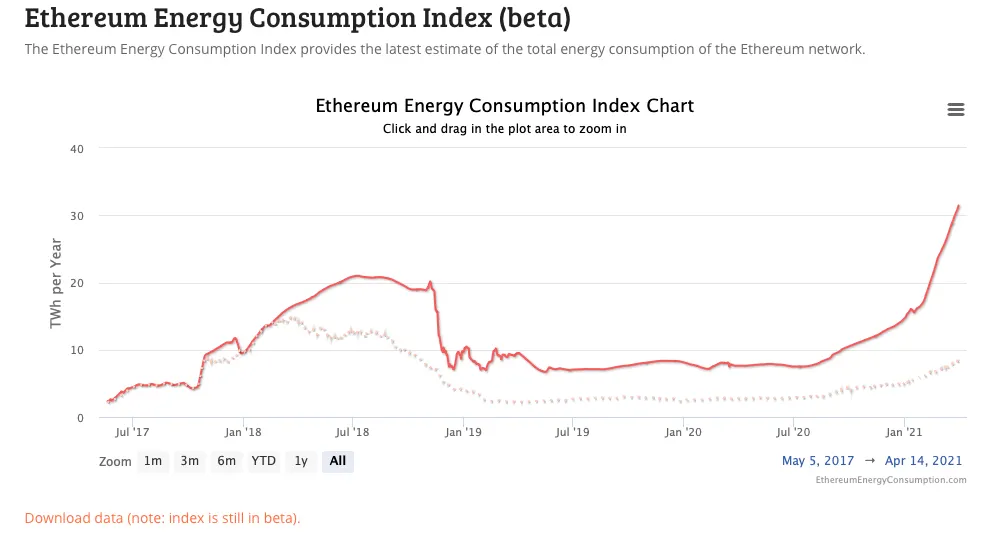In brief
- Ethereum and Bitcoin's energy needs have surged in the last six months.
- Critics are calling for more energy-efficient ways of keeping networks secure.
- A variety of projects are working on new solutions.
While blockchain technology and the cryptocurrency markets have drawn a mix of praise and pessimism for its ability to generate wealth seemingly from nowhere, the industry has drawn critics of a different creed: climate change advocates.
Bitcoin’s energy consumption has been steadily trickling up in line with the boom in the asset’s underlying price. According to estimates by the University of Cambridge, the Bitcoin network consumes somewhere in the region of 130 terawatt-hours per year, or around the same amount of energy as Argentina uses.

Bitcoin’s consumption has doubled in less than six months as more miners compete for rewards set by the network.
But more recently, the explosion in the buying and selling of NFTs has brought other networks under the carbon emission spotlight.
According to Digiconomist, Ethereum, the blockchain used by the majority of NFTs, consumes almost 30 terawatt-hours per year. That put’s the network’s consumption on a par with a country like Bahrain. Ethereum’s energy consumption has, like Bitcoin, being surging recently.

From averages of around 8 TWh in August 2020, the world’s second-largest cryptocurrency sits at around 30 THw today, representing an increase of 275% in under a year, according to Digiconomist.
The environmental backlash has caused some projects to rethink Ethereum and NFTs more broadly as a platform to roll out new products.
However, the increased scrutiny has created a mini-boom for projects and technologies that can help offset, or even reduce crypto’s carbon footprint.
From proof of work to proof of stake
One of the underlying reasons why some cryptocurrencies are so energy-intensive is the methods they use to validate transactions. Proof-of-work is a consensus protocol that relies on huge amounts of computing power to try and solve a puzzling problem that is used to ensure all the transactions in the blockchain are correct.
Miners are competing for block rewards, an amount of cryptocurrency the network allocates to the miner that solved the puzzle first. This is a lucrative business. In January alone, Bitcoin miners earned $1.1 billion, taking Bitcoin mining revenue since the network’s inception to more than $20 billion.
However, all the computing power expended by miners who did not solve the block and claim the reward is effectively wasted. At present, both Bitcoin and Ethereum, the two biggest energy users in the space use proof of work. While Bitcoin developers have been sluggish in their efforts to address energy concerns, Ethereum has been slowly moving towards a different, more energy-efficient consensus protocol, proof-of-stake.
Instead of miners competing for the block rewards, a voting system based on how much of the underlying currency a miner or validator holds will be used to decide which miner gets to validate the block. Ethereum’s efforts to transition between protocols is currently underway, but is still several years away from completion. That has led to a slew of new networks offering more energy-efficient ways of keeping the lights on.
New lower-energy networks
Over the last two years, a number of projects have embraced the proof-of-stake consensus protocol, the largest currently are Cardano, Polkadot and Avalanche. According to Cardano founder Charles Hoskinson, his network consumes only 6 GWh of power, a tiny fraction of what Bitcoin uses.
Other large networks have gone further. Near Protocol and Algorand both claim to have carbon-neutral blockchains and boast an array of green credentials.
Some have taken a different approach, by creating ultra-low blockchain networks that can be maintained via mobile phones.
Pi Network, a new cryptocurrency project launched by a group of Stanford graduates earlier this year is designed to rely on a different approach to securing a network.
The Pi Network is comprised of what its team refers to as “security circles.” These are groups consisting of different users that have been vouched for by their peers. Once a user has been deemed trustworthy by other members of a group, these users are permitted to validate future transactions on Pi’s blockchain.
Additionally, Pi members can mine new tokens directly from their smartphones, a relatively low-cost process that requires minimal battery power. Since the project’s launch, it’s attracted more than 500,000 users.
Pi isn’t the only project exploring smartphone mining. Electroneum, a British cryptocurrency launched in 2017 is also light enough to run on smartphones and has seen much of its growth in Africa and Asia. Since its launch, it’s grown to 4.2 million users.
While these are no doubt impressive, they don’t stop networks like Bitcoin and Ethereum from churning out thousands of tons of CO2.
At present, according to the University of Cambridge’s Centre for Alternative Finance, around 40% of Bitcoin’s power comes from renewable sources.
When compared to the world’s largest economies, Bitcoin is surprisingly green. The European Union derives 18% of its energy needs from renewables, while the US only creates 10% of its energy from wind, solar, and other sources like hydroelectricity, according to the World Bank.

Despite this, there are still calls for more to be done to reduce BTC’s energy usage. One such solution is Bitcoin Zero, a token created by Universal Protocol Alliance that ‘wraps’ Bitcoin in an ERC-20 token to allow carbon offsetting.
Each time a Bitcoin zero is minted, it ‘retires’ 10 tonnes of CO2 via its partnership with REDD+ rainforest projects.
On Ethereum there have been similar efforts to curb the network’s power usage. ConsenSys—the Ethereum studio behind MetaMask—has built a new protocol on a ‘sidechain’ of Ethereum specifically for crypto art to reduce the amount of energy used in the minting of new NFTs.
The network, called Palm is built adjacent to the main Ethereum network, allowing it to interact with Ethereum without having to rely on its underlying infrastructure to verify transactions.
Whereas Ethereum is powered by the proof-of-work consensus mechanism, the Palm sidechain runs on proof-of-authority, which dramatically reduces its energy consumption. The Palm sidechain will also allow for tokens to be transferred to the Ethereum mainnet.
Press materials declare that Palm will be “99% more efficient than Layer 1 Ethereum [i.e. the entire system’s underlying architecture].”
If successful, the project could help reduce Ethereum's soaring energy usage. With a growing number of scientists suggesting the world has passed a point of no return for climate change, it couldn't come soon enough.
This post was created in partnership with Saidler & Co.
Sponsored post by Saidler & Co.
Learn More about partnering with Decrypt.

